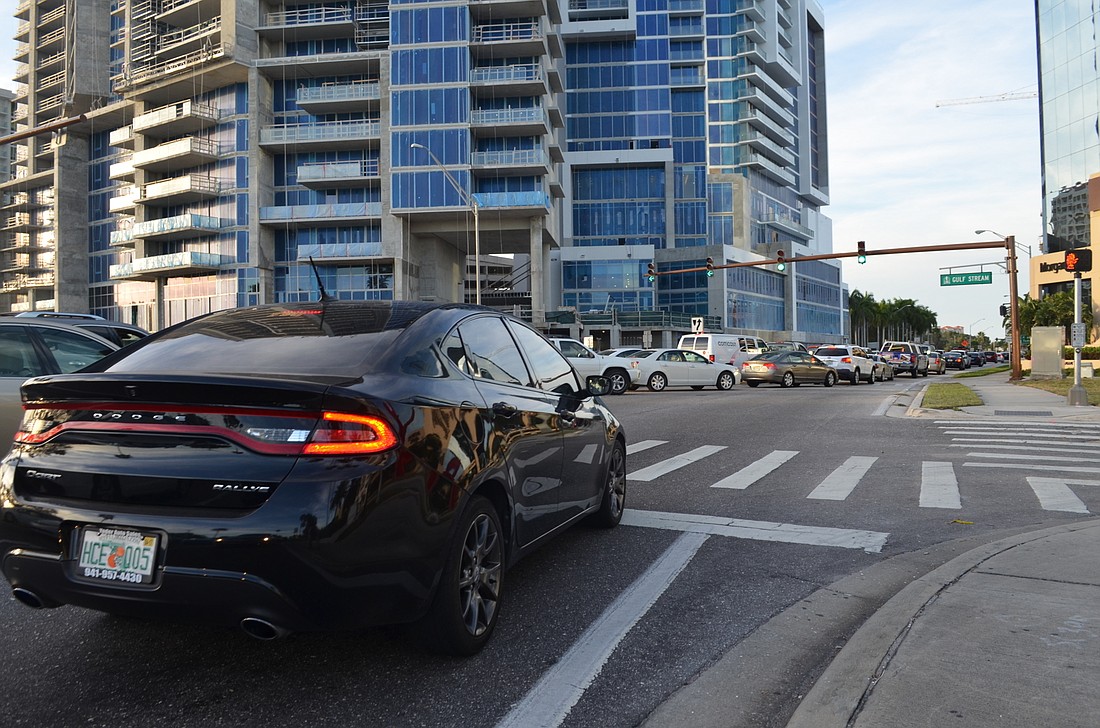- October 23, 2024
-
-
Loading

Loading

On Aug. 14, Sarasota City Manager Tom Barwin heard an appeal from barrier island residents lobbying for changes to U.S. 41 in hopes of improving the seasonal traffic congestion near the state highway’s intersections with Gulfstream Avenue and Fruitville Road.
Barwin said he was sympathetic to their concerns, but he was dubious of a proposal to add a third northbound lane on U.S. 41 between Gulfstream and Fruitville. The city’s goal, he said, was enhancing pedestrian safety on the road. He didn’t think adding a sixth lane to that segment of U.S. 41 would help achieve that goal.
“All of this angst is understandable, but it really amounts to about 5% of the time,” Barwin said. “You don’t, I think, dramatically change the character of an urbanized downtown and create really irresponsible pedestrian safety risks for 5% of the time.”
On Monday, however, the City Commission split with Barwin, voting unanimously to undertake a series of changes to the U.S. 41-Gulfstream-Fruitville road network. Those changes include a third northbound lane on U.S. 41, a third left-turn lane from eastbound Gulfstream onto U.S. 41 and a signalized pedestrian crosswalk near First Street and Ritz-Carlton Drive on U.S. 41. The state would also reduce the speed limit along that segment of U.S. 41 from 40 mph to 35 mph.
Florida Department of Transportation officials, present at Monday’s commission meeting, said the extra lane was necessary to offset the effects of the First Street crosswalk. The state agency, which manages all three roads, framed the plan as a compromise that would increase pedestrian activity across U.S. 41 while acknowledging the need to move cars along the road, especially in light of concerns brought forward by barrier island residents and business operators.
It’s unclear when the changes will go into effect, but FDOT District 1 Secretary L.K. Nandam said he hoped the new traffic configuration would be in place before the end of the year.
Residents from Longboat Key, Lido Key, St. Armands Key and Bird Key appeared at Monday’s commission meeting to support the proposed changes.
Longboat Mayor Terry Gans said the U.S. 41-Gulfstream intersection is a crucial access point for people traveling to and from the town. He asked the city to consider its neighbors and prioritize addressing congestion in the area.
“The thinking is, more lanes move more traffic,” Gans said.
One Sarasota resident questioned whether the extra lane would actually reduce congestion — if the flow of traffic improves, would more drivers flood the roadway until it grinds to a halt again?
FDOT's Nandam argued that wouldn’t be the case, because the congestion is linked to differing traffic conditions in and out of season, rather than overall growth in the area. Even with the changes, Nandam said driving along Gulfstream and U.S. 41 in-season wouldn’t become an appealing prospect. The goal is simply to make it more manageable.
“When you’re trying to manage congestion, where is the room for more traffic?” Nandam said.
Commissioner Hagen Brody asked whether the installation of a pedestrian-activated crosswalk signal at First Street would offset the benefits of adding a third lane on U.S. 41.
“My concern is that a consistent flow of pedestrians will actually work against what we’re trying to do here,” Brody said.
City Engineer Alex DavisShaw said the pedestrian signals, known as hawk beacons, could be timed to space out any delays in traffic. Still, the models FDOT officials shared Monday indicated the average peak-hour delay for cars travelling from eastbound Gulfstream to Fruitville Road would be twice as long with the proposed changes relative to the existing conditions — an average of 117 seconds versus 61 seconds currently.
Nandam made clear that the planned changes are, in essence, a placeholder until the state can install a roundabout at the U.S. 41-Gulfstream intersection in 2019. Although FDOT officials endorsed the plans for redesigning U.S. 41, they said more significant improvements to vehicular and pedestrian traffic along the highway would likely have to wait until the roundabouts are in place.
“That’s what’s going to get you where you need to be,” Nandam said. “That’s what’s going to provide the balance.”